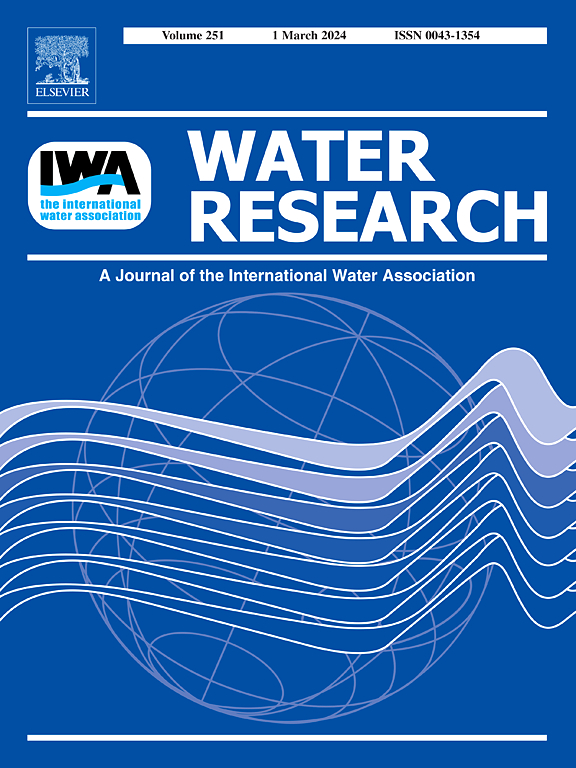Demonstrating performance in scaled-up production and quality control of polyhydroxyalkanoates using municipal waste activated sludge
IF 11.4
1区 环境科学与生态学
Q1 ENGINEERING, ENVIRONMENTAL
引用次数: 0
Abstract
Significant progress has been made over the past decade with pilot scale polyhydroxyalkanoate (PHA) production by direct accumulation using municipal waste activated sludge (WAS). However, industrial upscaling experiences are still lacking in the research literature. In this study, a demonstration scale (4 m3) PHA production process was operated using industrially relevant equipment and compared favourably to those from parallel pilot scale (200 L) production runs. WAS grab samples from a Dutch full scale municipal wastewater treatment plant (WWTP) was used as the biomass source. Final biomass PHA contents and production yields, that are critical for technology viability, were statistically the same between the experiments conducted at pilot scale (0.41 ± 0.02 gPHA/gVSS and 0.42 ± 0.02 gCOD/gCOD) and demonstration scale (0.45 ± 0.05 gPHA/gVSS and 0.39 ± 0.07 gCOD/gCOD). The results furthermore aligned with previous 1 m3 piloting experiences and five year old historical data that similarly used WAS sourced from the same WWTP. Scalability for the technology and a robustness of the applied PHA production methods using WAS were demonstrated. Temperature and foaming control were identified to be critical to upscaled process engineering and design towards successful industrial implementations. The results of the present study, combined with previously produced PHAs and those historical data, support that feedstock quality predictably determines both the average PHA co-monomer content, as well as the blend distribution. PHA solvent extraction from WAS is inherently a blending process. Extraction homogeneously mixes polymer contributions from collectively stored granules from all species of microorganisms in the biomass. Dried PHA-rich biomass batches can be stockpiled and batches can be blended in extraction processes for both recovery and formulation to reach consistent polymer qualities across production batches. More centralized extraction facilities are therefore anticipated to offer economic benefits due to scale and greater opportunities for product quality specification and control. Research findings are presented herein of the production scale comparative study along with practical perspectives of technological readiness for realizing WAS based industrial scale PHA production, quality control, and the supply chains that will be necessary for successful commercial implementation.求助全文
约1分钟内获得全文
求助全文
来源期刊

Water Research
环境科学-工程:环境
CiteScore
20.80
自引率
9.40%
发文量
1307
审稿时长
38 days
期刊介绍:
Water Research, along with its open access companion journal Water Research X, serves as a platform for publishing original research papers covering various aspects of the science and technology related to the anthropogenic water cycle, water quality, and its management worldwide. The audience targeted by the journal comprises biologists, chemical engineers, chemists, civil engineers, environmental engineers, limnologists, and microbiologists. The scope of the journal include:
•Treatment processes for water and wastewaters (municipal, agricultural, industrial, and on-site treatment), including resource recovery and residuals management;
•Urban hydrology including sewer systems, stormwater management, and green infrastructure;
•Drinking water treatment and distribution;
•Potable and non-potable water reuse;
•Sanitation, public health, and risk assessment;
•Anaerobic digestion, solid and hazardous waste management, including source characterization and the effects and control of leachates and gaseous emissions;
•Contaminants (chemical, microbial, anthropogenic particles such as nanoparticles or microplastics) and related water quality sensing, monitoring, fate, and assessment;
•Anthropogenic impacts on inland, tidal, coastal and urban waters, focusing on surface and ground waters, and point and non-point sources of pollution;
•Environmental restoration, linked to surface water, groundwater and groundwater remediation;
•Analysis of the interfaces between sediments and water, and between water and atmosphere, focusing specifically on anthropogenic impacts;
•Mathematical modelling, systems analysis, machine learning, and beneficial use of big data related to the anthropogenic water cycle;
•Socio-economic, policy, and regulations studies.
 求助内容:
求助内容: 应助结果提醒方式:
应助结果提醒方式:


